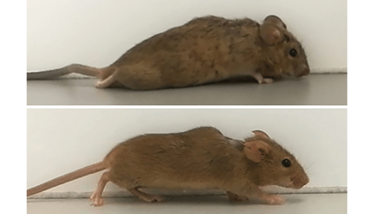Paralyzed Mice Walk Again
Mice with severed spinal cords walk again after gene therapy

Paralyzed mice have walked again – a research first – following gene therapy treatment. A team from Ruhr University of Bochum, Germany, delivered an AAV expressing the designer cytokine, hIL-6 – previously used to stimulate nerve cell regeneration in the visual system – to the sensorimotor cortex of mice with complete cross-sectional injury. The mice were then able to produce hIL-6 themselves and deliver it to serotonergic brainstem neurons (1).
The result? “The previously paralyzed animals that received this treatment started walking after two to three weeks,” said Dietmar Fischer, Chair of Cell Physiology at Ruhr and corresponding author, in a press release (2). “This came as a great surprise to us at the beginning, as it had never been shown to be possible before after full paraplegia.”
- M Leibinger et al., Nat Comm, 12, 391 (2021). PMID: 33452250.
- RUB (2021). Available at: https://bit.ly/2MKSoU0.

Over the course of my Biomedical Sciences degree it dawned on me that my goal of becoming a scientist didn’t quite mesh with my lack of affinity for lab work. Thinking on my decision to pursue biology rather than English at age 15 – despite an aptitude for the latter – I realized that science writing was a way to combine what I loved with what I was good at.
From there I set out to gather as much freelancing experience as I could, spending 2 years developing scientific content for International Innovation, before completing an MSc in Science Communication. After gaining invaluable experience in supporting the communications efforts of CERN and IN-PART, I joined Texere – where I am focused on producing consistently engaging, cutting-edge and innovative content for our specialist audiences around the world.



















